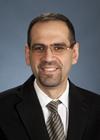
Instructor Waleed Khalil has co-published a couple of new papers that are freely accessible in the IEEE Access publication.
The first one is Phase Error Evaluation in a Two-Path Receiver Front-End With On-Site Coding:
Recently, we proposed a code-modulated multipath receiver front-end to reduce the number of analog-to-digital converters (ADCs) behind antenna elements and realize significant area, cost, and power reduction. More specifically, code division multiplexing was implemented at the analog front-end for path combining into a single ADC. At the digital baseband, the reverse process was applied to recover signals pertaining to each path. Such front-ends are suitable for spatial diversity and multiplexing and for beamforming. For the latter, it is important to accurately predict the angle of arrival. That is, it is important to faithfully recover the phase difference between adjacent signal paths at the digital baseband. In this paper, the impact of on-site coding on phase error is examined for a two-path receiver using orthogonal Walsh-Hadamard codes of length 8. Simulations show that the relative phase difference, Δφ, between signal paths can be faithfully recovered at the digital baseband. Hardware implementation of a two-path receiver with on-site coding was realized and three different phase measurements were conducted, namely, Δφ = 27°, 40°, and 45°. These measurements confirmed that upon signal and code synchronization, the phases were faithfully recovered with minimal degradation.
The second paper is Code Optimization for a Code-Modulated RF Front End:
Recently, a novel class of on-site coding receivers was proposed. The architecture is suitable for digital beamforming in addition to offering multiple-input multiple-output capabilities. Essential to its realization is a code division multiplexing technique aggregating multiple signal paths at the analog front end into a single analog-to-digital converter. As a result, a significant hardware reduction and a higher power efficiency are achieved when compared with the conventional digital beamforming techniques. In this paper, we examine the system's performance with different types of spreading codes, both orthogonal and nonorthogonal, namely Walsh-Hadamard and Gold codes. Bit error rate calculations show that Walsh-Hadamard codes outperform Gold codes in achieving higher dynamic range with less signal-to-noise ratio degradation, assuming a perfectly synchronous system.
